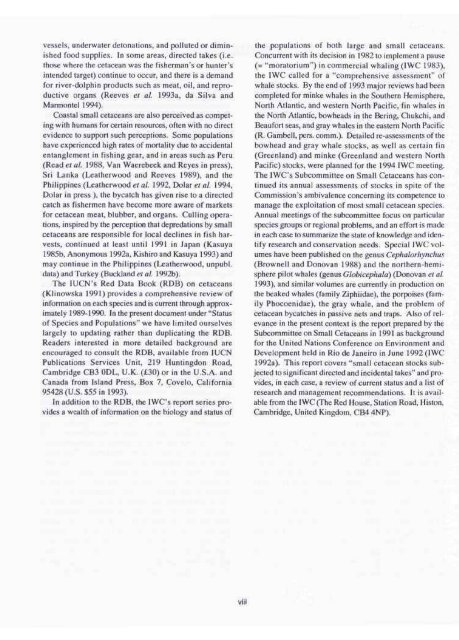Dolphins, Porpoises, and Whales - IUCN
Dolphins, Porpoises, and Whales - IUCN
Dolphins, Porpoises, and Whales - IUCN
You also want an ePaper? Increase the reach of your titles
YUMPU automatically turns print PDFs into web optimized ePapers that Google loves.
vessels, underwater detonations, <strong>and</strong> polluted or diminished<br />
food supplies. In some areas, directed takes (i.e.<br />
those where the cetacean was the fisherman's or hunter's<br />
intended target) continue to occur, <strong>and</strong> there is a dem<strong>and</strong><br />
for river-dolphin products such as meat, oil, <strong>and</strong> reproductive<br />
organs (Reeves et al. 1993a, da Silva <strong>and</strong><br />
Marmontel 1994).<br />
Coastal small cetaceans are also perceived as competing<br />
with humans for certain resources, often with no direct<br />
evidence to support such perceptions. Some populations<br />
have experienced high rates of mortality due to accidental<br />
entanglement in fishing gear, <strong>and</strong> in areas such as Peru<br />
(Read et al. 1988, Van Waerebeek <strong>and</strong> Reyes in press),<br />
Sri Lanka (Leatherwood <strong>and</strong> Reeves 1989), <strong>and</strong> the<br />
Philippines (Leatherwood e/a/. 1992, Dolar et a/. 1994,<br />
Dolar in press ), the bycatch has given rise to a directed<br />
catch as fishermen have become more aware of markets<br />
for cetacean meat, blubber, <strong>and</strong> organs. Culling operations,<br />
inspired by the perception that depredations by small<br />
cetaceans are responsible for local declines in fish harvests,<br />
continued at least until 1991 in Japan (Kasuya<br />
1985b, Anonymous 1992a, Kishiro <strong>and</strong> Kasuya 1993) <strong>and</strong><br />
may continue in the Philippines (Leatherwood, unpubl.<br />
data) <strong>and</strong> Turkey (Buckl<strong>and</strong> et al. 1992b).<br />
The lUCN's Red Data Book (RDB) on cetaceans<br />
(Klinowska 1991) provides a comprehensive review of<br />
information on each species <strong>and</strong> is current through approximately<br />
1989-1990. In the present document under "Status<br />
of Species <strong>and</strong> Populations" we have limited ourselves<br />
largely to updating rather than duplicating the RDB.<br />
Readers interested in more detailed background are<br />
encouraged to consult the RDB, available from lUCN<br />
Publications Services Unit, 219 Huntingdon Road,<br />
Cambridge CB3 ODL, U.K. (£30) or in the U.S.A. <strong>and</strong><br />
Canada from Isl<strong>and</strong> Press, Box 7, Covelo, California<br />
95428 (U.S. $55 in 1993).<br />
In addition to the RDB, the IWC's report series provides<br />
a wealth of information on the biology <strong>and</strong> status of<br />
VIII<br />
the populations of both large <strong>and</strong> small cetaceans.<br />
Concurrent with its decision in 1982 to implement a pause<br />
(= "moratorium") in commercial whaling (IWC 1983),<br />
the IWC called for a "comprehensive assessment" of<br />
whale stocks. By the end of 1993 major reviews had been<br />
completed for minke whales in the Southern Hemisphere,<br />
North Atlantic, <strong>and</strong> western North Pacific, fin whales in<br />
the North Atlantic, bowheads in the Bering, Chukchi, <strong>and</strong><br />
Beaufort seas, <strong>and</strong> gray whales in the eastern North Pacific<br />
(R. Gambell, pers. comm.). Detailed re-assessments of the<br />
bowhead <strong>and</strong> gray whale stocks, as well as certain fin<br />
(Greenl<strong>and</strong>) <strong>and</strong> minke (Greenl<strong>and</strong> <strong>and</strong> western North<br />
Pacific) stocks, were planned for the 1994 IWC meeting.<br />
The IWC's Subcommittee on Small Cetaceans has continued<br />
its annual assessments of stocks in spite of the<br />
Commission's ambivalence concerning its competence to<br />
manage the exploitation of most small cetacean species.<br />
Annual meetings of the subcommittee focus on particular<br />
species groups or regional problems, <strong>and</strong> an effort is made<br />
in each case to summarize the state of knowledge <strong>and</strong> identify<br />
research <strong>and</strong> conservation needs. Special IWC volumes<br />
have been published on the genus Cephalorhynchus<br />
(Brownell <strong>and</strong> Donovan 1988) <strong>and</strong> the northern-hemisphere<br />
pilot whales (genus Globicephala) (Donovan et al.<br />
1993), <strong>and</strong> similar volumes are currently in production on<br />
the beaked whales (family Ziphiidae), the porpoises (family<br />
Phocoenidae), the gray whale, <strong>and</strong> the problem of<br />
cetacean bycatches in passive nets <strong>and</strong> traps. Also of relevance<br />
in the present context is the report prepared by the<br />
Subcommittee on Small Cetaceans in 1991 as background<br />
for the United Nations Conference on Environment <strong>and</strong><br />
Development held in Rio de Janeiro in June 1992 (IWC<br />
1992a). This report covers "small cetacean stocks subjected<br />
to significant directed <strong>and</strong> incidental takes" <strong>and</strong> provides,<br />
in each case, a review of current status <strong>and</strong> a list of<br />
research <strong>and</strong> management recommendations. It is available<br />
from the IWC (The Red House, Station Road, Histon,<br />
Cambridge, United Kingdom, CB4 4NP).

















